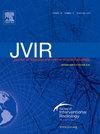微波消融肝脏中难治性寡转移非小细胞肺癌
IF 2.6
3区 医学
Q2 PERIPHERAL VASCULAR DISEASE
Journal of Vascular and Interventional Radiology
Pub Date : 2025-02-01
DOI:10.1016/j.jvir.2024.10.017
引用次数: 0
摘要
目的评估微波消融(MWA)治疗非小细胞肺癌(NSCLC)继发肝转移(LM)的安全性和有效性:这项回顾性研究纳入了2015年3月至2022年7月期间接受微波消融治疗的非小细胞肺癌患者。采用竞争风险分析和卡普兰-梅耶法估算了局部无肿瘤进展生存期(LTPFS)和总生存期(OS)。根据《不良事件通用术语标准》(CTCAE)v5.0记录了术后不良事件:23名患者在27次MWA治疗中切除了32个LM。最大指数肿瘤的尺寸为 1.96 ± 0.75 厘米(平均值 ± SD)。技术成功率为 100%。26/32个肿瘤(81.3%)获得了技术疗效。中位随访时间为 37.7 个月(IQR:20.5-54.5)。中位 LTPFS 为 16.3 个月(95% CI:7.87-44.10)。中位 OS 为 31.7 个月(95% CI:11.1 至 65.8 个月)。消融边缘是影响 LTPFS 的一个重要因素,与有可测量边缘的肿瘤相比,没有可测量边缘的肿瘤更有可能恶化(子分布危险比 [SHR] 0.008-0.024, pConclusion: :经皮MWA是一种安全的NSCLC LM治疗方法,年轻患者和无同步肺肿瘤患者的生存期更长。本文章由计算机程序翻译,如有差异,请以英文原文为准。

Microwave Ablation of Refractory Oligometastatic Non–Small Cell Lung Cancer in the Liver
Purpose
To evaluate safety and effectiveness of microwave ablation (MWA) in the treatment of liver metastases (LMs) secondary to non–small cell lung cancer (NSCLC).
Materials and Methods
This retrospective study included patients with NSCLC who underwent MWA of LM from March 2015 to July 2022. Local tumor progression-free survival (LTPFS) and overall survival (OS) were estimated using competing risk analysis and the Kaplan-Meier method. Postprocedural adverse events were recorded according to the Common Terminology Criteria for Adverse Events (CTCAE) v5.0.
Results
Twenty-three patients with 32 LMs were treated in 27 MWA sessions. The mean dimension of the largest index tumor was 1.96 cm (SD ± 0.75). Technical success was 100%. Technical effectiveness was achieved in 26 (81.3%) of 32 tumors. The median length of follow-up was 37.7 months (interquartile range, 20.5–54.5 months). The median LTPFS was 16.3 months (95% confidence interval [CI], 7.87–44.10 months). The median OS was 31.7 months (95% CI, 11.1–65.8 months). Ablation margin was a significant factor for LTPFS, with tumors ablated without a measurable margin being more likely to progress than those with measurable margins (subdistribution hazard ratios [HRs], 0.008–0.024; P < .001). Older age (HR, 1.18; 95% CI, 1.09–1.28; P < .001) and presence of synchronous lung metastases (HR, 14.73; 95% CI, 1.86–116.95; P = .011) were significant predictors of OS. Serious adverse events (CTCAE Grade ≥3) within 30 days occurred in 2 (7.4%) of 27 sessions, including pulmonary embolus and severe abdominal pain.
Conclusions
Percutaneous MWA was a safe treatment for NSCLC LM, with longer survival noted in younger patients and those without synchronous lung tumors.
求助全文
通过发布文献求助,成功后即可免费获取论文全文。
去求助
来源期刊
CiteScore
4.30
自引率
10.30%
发文量
942
审稿时长
90 days
期刊介绍:
JVIR, published continuously since 1990, is an international, monthly peer-reviewed interventional radiology journal. As the official journal of the Society of Interventional Radiology, JVIR is the peer-reviewed journal of choice for interventional radiologists, radiologists, cardiologists, vascular surgeons, neurosurgeons, and other clinicians who seek current and reliable information on every aspect of vascular and interventional radiology. Each issue of JVIR covers critical and cutting-edge medical minimally invasive, clinical, basic research, radiological, pathological, and socioeconomic issues of importance to the field.

 求助内容:
求助内容: 应助结果提醒方式:
应助结果提醒方式:


